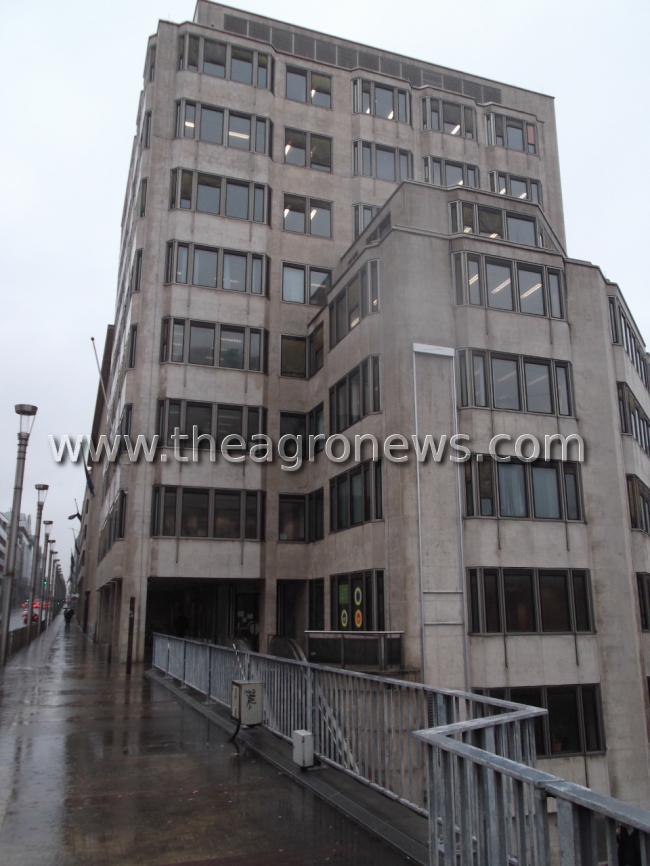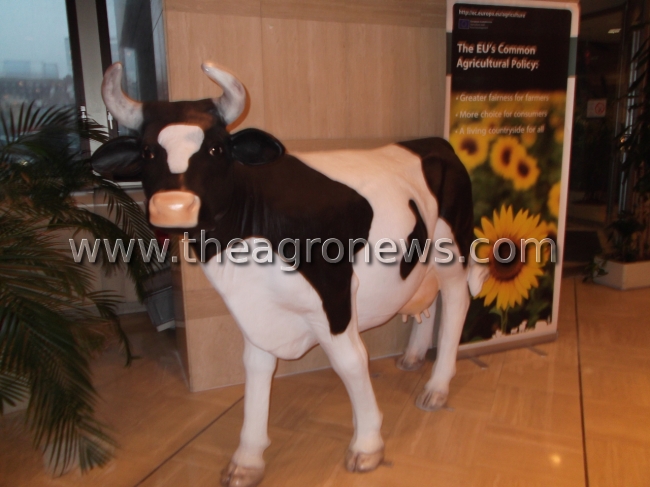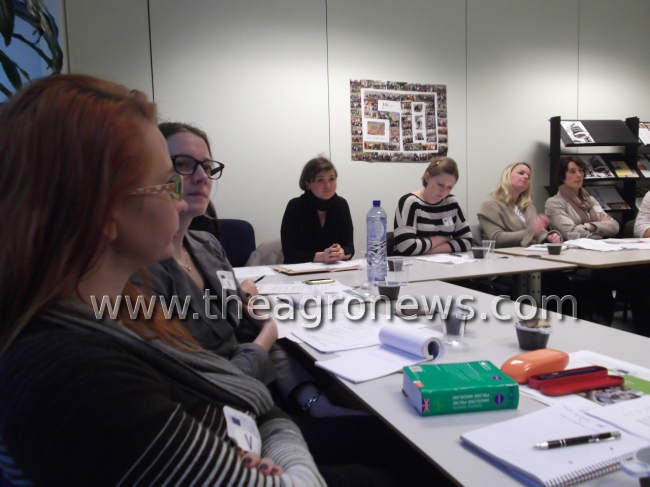Decía Arias Cañete antes de volver a ser ministro que «había que plantar y no sembrar». Era fácil escuchárselo comentar en público, no en petit comité, porque al fin y al cabo como terrateniente de la provincia de Cádiz y poseedor de muchos olivos era lo que más le convenía. Es lo que ‘los privilegiados’ promueven, esto es, no trabajar la tierra, sino mantener un sistema ficticio por superficie e historia. Ahora Cañete tendrá que lidiar en España con una guerra entre Comunidades Autónomas, que es lo que se avecina para el reparto de estas ayudas venidas de la lejana Europa.
Esa política comunitaria de agricultura de subvenciones arbitrarias se fragua en el edificio gris que aparece en la primera de las fotografías que ilustran este post.
Es la Dirección General de Agricultura, dependiente de la Comisión Europea, traducido al cristiano como el Ministerio de Agricultura de Europa. Allí Cañete es un ministro más y no precisamente el que más peso tiene. Me refiero a peso político.
UPA, COAG y Fepex piden que los agricultores de hortalizas cobren entre 2.500 y 3.000 euros por hectárea de fondos de la PAC
Es una petición formal trasladada a Miguel Arias Cañete por parte de las organizaciones agrarias UPA y COAG, más la organización empresarial Fepex. Me explicaba Roque García, miembro de UPA en el Consejo Consultivo de Frutas y Hortalizas, dependiente de la Comisión Europea, que ésta es una propuesta novedosa que se hace para equiparar a estos empresarios agrícolas con el resto de profesionales, ¿por qué no iba a tener el mismo derecho un agricultor de invernadero que un cerealista o un olivarero?
Sin embargo, es una reclamación que no prosperará, que quedará en saco roto, al igual que los fondos operativos, que no aumentarán su presupuesto pese a ser una reivindicación de todo el sector hortofrutícola. En Bruselas, esa ciudad gris donde se gesta la euroburocracia, importan más las vacas que los tomates. Sintomática es la vaca que acoge la entrada de ese edificio gris de la Dirección General de Agricultura. Ninguna otra referencia al mundo agrario en su vestíbulo ni en sus pasillos. El edificio en su interior bien podría ser el de una multinacional de software o el de una casa de automóviles.
En cualquier caso, la idea que tienen las organizaciones de productores españoles y Fepex es quitar una parte del dinero de la PAC a aquellos que cobran más de 300.000 euros. Con eso habría dinero para los de frutas y hortalizas, pero desde el Ministerio español hay muchas reticencias. No habría que olvidar aquel informe que reflejaba que el 80% de las ayudas de la PAC en España están domiciliadas en la calle Serrano de Madrid. Entre duquesas y terratenientes se reparten el presupuesto, que no llega a agricultores como Pepe Pérez que tiene un invernadero en la costa de Granada o Francisco Sánchez que lo tiene en el campo de Níjar en Almería.
La última fotografía que acompaño la hice en una pequeña sala de la susodicha Dirección General de Agricultura (Ministerio de Agricultura Europeo) en mi viaje de este año a Bruselas. Allí nos vendieron las bondades de la nueva PAC, lo maravillosa que es. Escuchaban estas explicaciones varias periodistas europeas, entre ellas de izquierda a derecha, compañeras de Polonia, Holanda, Eslovenia, Dinamarca, Finlandia e Irlanda. Por cierto, un saludo a todas ellas.
The CAP is a gray policy designed in a gray building of a gray city called Brussels
Arias Cañete said before being again a minister that “it was necessary to plant and not to sow”. It was easy to listen to him commenting in public, not in “petit comité”, because in the end as a landowner in the province of Cadiz and as a holder of many olive trees it was the most convenient thing for him. This is what ‘the privileged ones’ promote, that is, not work the land, but to keep a fictitious system for surface and history. Now Cañete will have to deal in Spain with a war between Autonomous Communities, which is what is coming for the distribution of this aid which comes from the distant Europe.
This community policy of arbitrary grant agriculture is forged in the gray building that appears on the first of the pictures that illustrate this post. It is the Directorate-General for Agriculture, depending on the European Commission, talking straight, the Ministry of Agriculture in Europe. There, Cañete is a minister more and not exactly the most important one. I mean political importance.
UPA, COAG and Fepex ask that vegetable farmer searn between 2,500 and 3,000 Euros per hectare of funds from the CAP
It is a formal request made to Miguel Arias Cañete by the UPA and COAG agricultural organizations, as well as the business organization Fepex. Roque Garcia, an UPA member on the Advisory Council of Fruits and Vegetables, which depends on the European Commission, explained to me that this is a new proposal made to match these agricultural entrepreneurs with the rest of professionals, why would not have the same right a greenhouse farmer than a cereal or olive ones?
However, it is a claim that will not be successful, it will be in vain, the same as all the operating funds, that will not increase their budget despite being a vindication of the whole horticultural sector. In Brussels, that gray town where the eurobureaucracy is developing, cows are more important than tomatoes. The cow that welcomes the entry of that gray building of the Directorate-General for Agriculture is symptomatic. There is no other reference to the agricultural world in the lobby or in the aisles. The building inside could well be the one of a software multinational or the one of a car lot.
In any case, the idea that the Spanish producer’s organizations and Fepex have is to take out a part of the money of the CAP to those who earn more than 300,000 Euros. With that there would be money for the fruit and vegetable ones, but in the Spanish Ministry there are many reservations. We should not forget that this report which reflect that the 80% of the CAP subsidies in Spain are domiciled at Serrano Street in Madrid. The budget is shared among duchesses and landowners, which does not reach farmers as Pepe Perez who has a greenhouse on the coast of Granada or Francisco Sanchez who has it in the field of Nijar in Almeria.
I took the last picture I put here in a small room of the aforesaid Directorate-General for Agriculture (European Ministry of Agriculture) on my last trip to Brussels (this year). There they sold us the benefits of the new CAP, how wonderful it is. Several European journalists listened to these explanations, including from left to right, colleages from Poland, the Netherlands, Slovenia, Denmark, Finland and Ireland. By the way, greetings to all them.













 José Antonio Arcos
José Antonio Arcos
 Ana Rubio
Ana Rubio
Mas de lo mismo ,sigue siendo un»sueño»que los políticos burócratas tomen decisiones que beneficien a la mayoría en perjuicio de unos pocos,pero poderosos. Lastima de sueldos que cobran,ejemplo:Joaquín almunia,comisario de la incompetencia.
Bruselas esta muy lejos de Almeria y nuestros politicos nacionales y europeos, no saben lo que es el mundo de las hortalizas del sureste de España